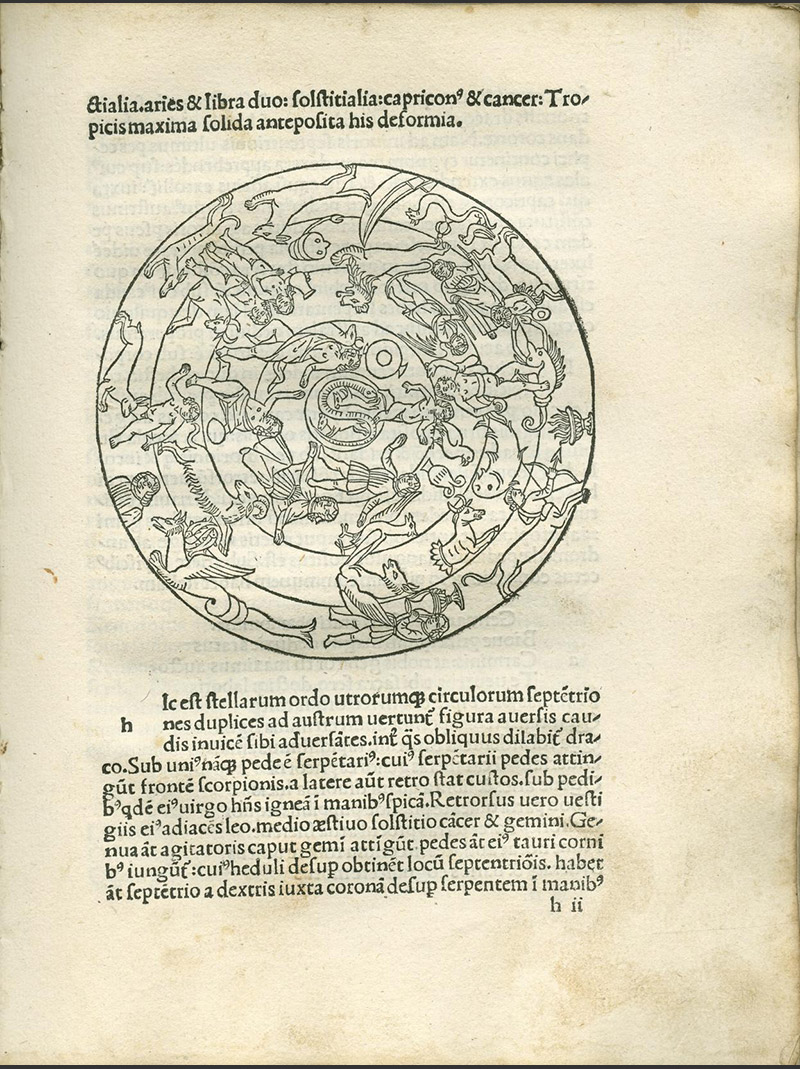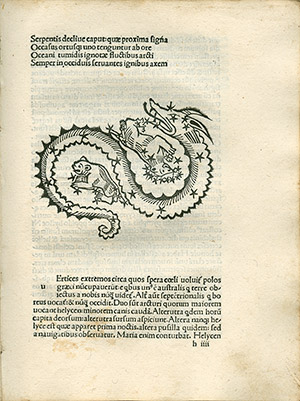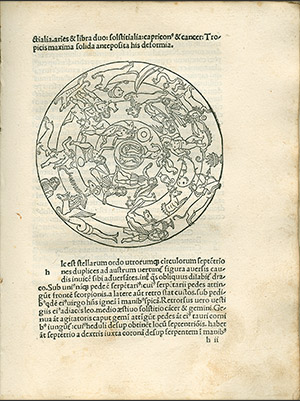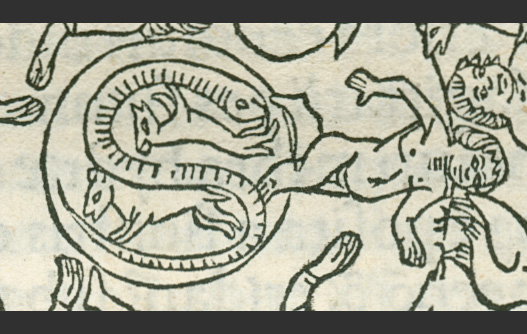Germanicus’ Aratea

- Germanicus, Aratea, lines 61-64 with the constellations of the Dragon, the Great Bear and the Small Bear and some annotations.
- Rufius Festus Avienus, Arati phaenomena. Ed: Victor Pisanus. Add: Dionysius Periegetes: De situ orbis (Tr: Avienus). Avienus: Ora maritima. Aratus: Phaenomena (Tr: Germanicus, with comm). Aratus: Phaenomena (Tr: Cicero). Quintus Serenus Sammonicus: Carmen medicinale.
- Venice: Antonius de Strata, de Cremona, 25 Oct. 1488.

- Germanicus, Aratea, annotations and northern celestial hemisphere.
- Rufius Festus Avienus, Arati phaenomena. Ed: Victor Pisanus. Add: Dionysius Periegetes: De situ orbis (Tr: Avienus). Avienus: Ora maritima. Aratus: Phaenomena (Tr: Germanicus, with comm). Aratus: Phaenomena (Tr: Cicero). Quintus Serenus Sammonicus: Carmen medicinale.
- Venice: Antonius de Strata, de Cremona, 25 Oct. 1488.

- Germanicus, Aratea, northern celestial hemisphere, detail.
- Rufius Festus Avienus, Arati phaenomena. Ed: Victor Pisanus. Add: Dionysius Periegetes: De situ orbis (Tr: Avienus). Avienus: Ora maritima. Aratus: Phaenomena (Tr: Germanicus, with comm). Aratus: Phaenomena (Tr: Cicero). Quintus Serenus Sammonicus: Carmen medicinale.
- Venice: Antonius de Strata, de Cremona, 25 Oct. 1488.
Germanicus (15 BCE-19 CE) was a brilliant soldier and politician, destined to become the successor of Tiberius as emperor until his career was cut short by his early death. Highly educated, he wrote comedies in Greek and epigrams in Latin, but he is mostly famous for his translation of the astronomical part of Aratus’ Phaenomena (1-732), which was probably composed in ca. 16-17 CE. Interest in astronomy was indeed growing in Rome in that period: Caesar had reformed the calendar with the help of the astronomer Sosigenes, and astrology was becoming popular, as shown by the many Latin poets engaging with astronomy between the first century BCE and the first century CE (Lucretius in Book 5 of De rerum naturae, Virgil in the Georgics, Ovid in the Fasti, Manilius in his Astronomica).
The page displayed here (see the first image) is taken from the 1488 edition containing the translations of Avienus and of Cicero. The volume contains a selection of Germanicus’ Aratea, alternating with some scholia (that is, annotations found in the margin of medieval manuscripts and dating back form the early Roman period to Late antiquity); this page in particular contains lines 61-64 of Germanicus’ Aratea (which translates, with additions, Aratus’ Phaenomena 61-62); they describe the Dragon as being a circumpolar constellation in that it never rises or sets but whose head lightly touches the horizon without ever setting. These lines are followed by a representation of the Dragon between the two Bears, as both Aratus and Germanicus describe it and as the Latin scholium below further explains.
Germanicus was not an astronomer, so he did not make his own observations. Nevertheless, Germanicus at times corrected Aratus on the basis of Hipparchus’ criticism. For example, Aratus said that the Kneeler had his right foot on the head of the Dragon (Phaen. 69-70: “He has the tip of the right foot above the middle of the head of the tortuous Dragon”). Hipparchus (1.2.§6) criticized this claim, saying that the Kneeler had the left, not the right foot on the head of the Dragon. Interestingly, when translating these lines of Aratus, Germanicus corrects the mistake and says that the Kneeler fixes his left foot on the head of the Dragon (Phaen. 69: Serpentis capiti figit uestigia laeua). In this other image taken from the same 1488 edition we see the northern celestial hemisphere as described by Germanicus: the Renaissance editor has followed Germanicus in having the left foot of the Kneeler (= Heracles) touching the head of the Dragon (see detail).
Select Bibliography
- Le Bœuffle, André. 2003 (pr. éd. 1975). Germanicus, Les phénomènes d’Aratos. Collection des Universités de France. Paris: Les Belles Lettres.
- Possanza, D. Mark. 2004. Translating the Heavens: Aratus, Germanicus, and the Poetics of Latin Translation. Lang Classical Studies. New York: Lang.


